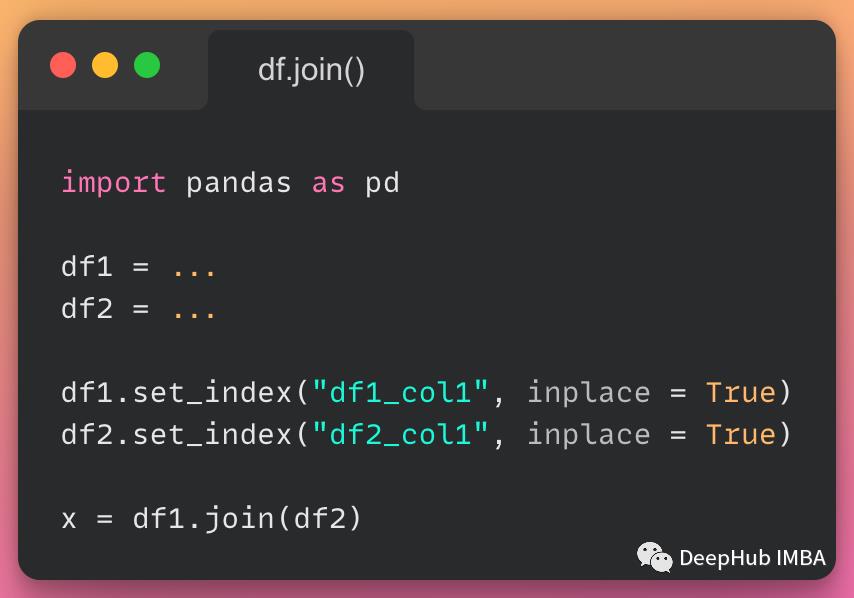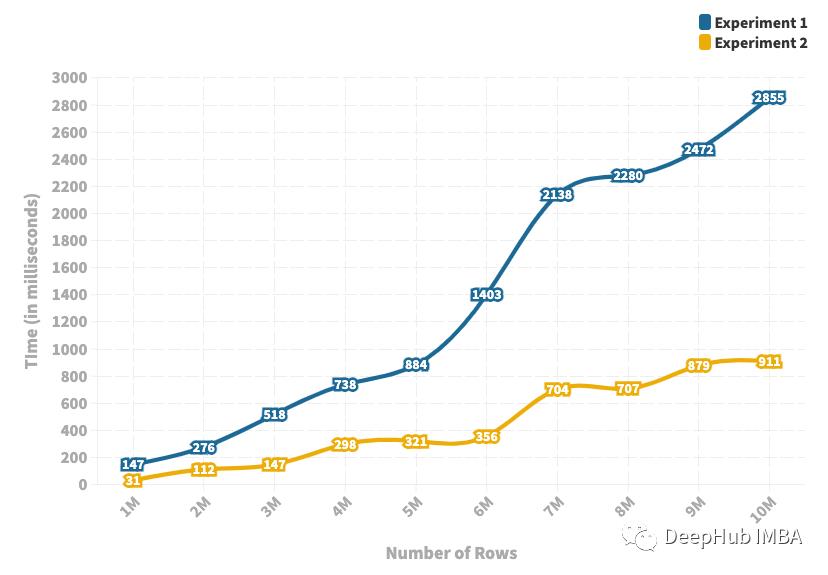实测,在 Pandas 中使用 MergeJoin Concat合并数据的效率对比!
Posted Wang_AI
tags:
篇首语:本文由小常识网(cha138.com)小编为大家整理,主要介绍了实测,在 Pandas 中使用 MergeJoin Concat合并数据的效率对比!相关的知识,希望对你有一定的参考价值。
来源:Deephub Imba
本文约1400字,建议阅读15分钟
在 Pandas 中有很多种方法可以进行DF的合并。本文将研究这些不同的方法,以及如何将它们执行速度的对比。合并DF
Pandas 使用 .merge() 方法来执行合并。
import pandas as pd
# a dictionary to convert to a dataframe
data1 = 'identification': ['a', 'b', 'c', 'd'],
'Customer_Name':['King', 'West', 'Adams', 'Mercy'], 'Category':['furniture', 'Office Supplies', 'Technology', 'R_materials'],
# our second dictionary to convert to a dataframe
data2 = 'identification': ['a', 'b', 'c', 'd'],
'Class':['First_Class', 'Second_Class', 'Same_day', 'Standard Class'],
'Age':[60, 30, 40, 50]
# Convert the dictionary into DataFrame
df1 = pd.DataFrame(data1)
df2 = pd.DataFrame(data2)运行我们的代码后,有两个 DataFrame,如下所示。
identification Customer_Name Category
0 a King furniture
1 b West Office Supplies
2 c Adams Technology
3 d Mercy R_materials
identification Class Age
0 a First_Class 60
1 b Second_Class 30
2 c Same_day 40
3 d Standard Class 50使用 merge() 函数进一步合并。

# using .merge() function
new_data = pd.merge(df1, df2, on='identification')这产生了下面的新数据;
identification Customer_Name Category Class Age
0 a King furniture First_Class 60
1 b West Office Supplies Second_Class 30
2 c Adams Technology Same_day 40
3 d Mercy R_materials Standard Class 50.join() 方法也可以将不同索引的 DataFrame 组合成一个新的 DataFrame。我们可以使用参数‘on’参数指定根据哪列进行合并。

让我们看看下面的例子,我们如何将单索引 DataFrame 与多索引 DataFrame 连接起来;
import pandas as pd
# a dictionary to convert to a dataframe
data1 =
'Customer_Name':['King', 'West', 'Adams'],
'Category':['furniture', 'Office Supplies', 'Technology'], 7
# our second dictionary to convert to a dataframe
data2 =
'Class':['First_Class', 'Second_Class', 'Same_day', 'Standard Class'],
'Age':[60, 30, 40, 50]
# Convert the dictionary into DataFrame
Ndata = pd.DataFrame(data1, index=pd.Index(['a', 'b', 'c'], name='identification'))
index = pd.MultiIndex.from_tuples([('a', 'x0'), ('b', 'x1'),
('c', 'x2'), ('c', 'x3')],
names=['identification', 'x']) 19
# Convert the dictionary into DataFrame
Ndata2 = pd.DataFrame(data2, index= index)
print(Ndata, "\\n\\n", Ndata2)
# joining singly indexed with
# multi indexed
result = Ndata.join(Ndata2, how='inner')我们的结果如下所示;
Customer_Name Category Class Age
identification x 3 a x0 King furniture First_Class 60
b x1 West Office Supplies Second_Class 30
c x2 Adams Technology Same_day 40
x3 Adams Technology Standard Class 50连接DF
Pandas 中concat() 方法在可以在垂直方向(axis=0)和水平方向(axis=1)上连接 DataFrame。我们还可以一次连接两个以上的 DataFrame 或 Series。
让我们看一个如何在 Pandas 中执行连接的示例;
import pandas as pd
# a dictionary to convert to a dataframe
data1 = 'identification': ['a', 'b', 'c', 'd'],
'Customer_Name':['King', 'West', 'Adams', 'Mercy'],
'Category':['furniture', 'Office Supplies', 'Technology', 'R_materials'],
# our second dictionary to convert to a dataframe
data2 = 'identification': ['a', 'b', 'c', 'd'],
'Class':['First_Class', 'Second_Class', 'Same_day', 'Standard Class'],
'Age':[60, 30, 40, 50]
# Convert the dictionary into DataFrame
df1 = pd.DataFrame(data1)
df2 = pd.DataFrame(data2)
#perform concatenation here based on horizontal axis
new_data = pd.concat([df1, df2], axis=1)
print(new_data)这样就获得了新的 DataFrame :
identification Customer_Name Category identification \\
0 a King furniture a 3 1 b West Office Supplies b 4 2 c Adams Technology c 5 3 d Mercy R_materials d
Class Age
0 First_Class 60
1 Second_Class 30
2 Same_day 40
3 Standard Class 50Merge和Join的效率对比
Pandas 中的Merge Joins操作都可以针对指定的列进行合并操作(SQL中的join)那么他们的执行效率是否相同呢?下面我们来进行一下测。
两个 DataFrame 都有相同数量的行和两列,实验中考虑了从 100 万行到 1000 万行的不同大小的 DataFrame,并在每次实验中将行数增加了 100 万。我对固定数量的行重复了十次实验,以消除任何随机性。下面是这十次试验中合并操作的平均运行时间。

上图描绘了操作所花费的时间(以毫秒为单位)。
正如我们从图中看到的,运行时间存在显着差异——最多相差 5 倍。随着 DataFrame 大小的增加,运行时间之间的差异也会增加。两个 JOIN 操作几乎都随着 DataFrame 的大小线性增加。但是,Join的运行时间增加的速度远低于Merge。
如果需要处理大量数据,还是请使用join()进行操作。
 CSDN 社区图书馆,开张营业!
CSDN 社区图书馆,开张营业!
 深读计划,写书评领图书福利~
深读计划,写书评领图书福利~
以上是关于实测,在 Pandas 中使用 MergeJoin Concat合并数据的效率对比!的主要内容,如果未能解决你的问题,请参考以下文章